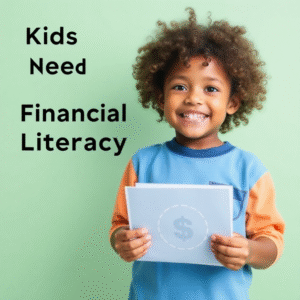
Let’s be real—navigating personal finance as an adult without any formal training is like being dropped into the outback without a compass. By the time a teenager finishes school, they’ll soon be facing mobile phone bills, student loans, part-time jobs, and eventually rent or mortgage decisions. Without a strong financial foundation, they’re set up to struggle.
In Australia, we pride ourselves on giving kids the tools to thrive—but when it comes to money management, we’re dropping the ball. If we want the next generation to have a fair crack at financial security, it’s time we treat financial literacy like the essential life skill it is.
Table of Contents
ToggleThe Financial Literacy Crisis in Australia
According to a 2022 Financial Review article, Aussies’ financial literacy is heading south—and fast. The Income and Labour Dynamics in Australia (HILDA) survey, which tracked responses from over 17,000 households, found a noticeable dip in scores between 2016 and 2020 across all age groups. Young Aussies, in particular, copped the biggest drop.
Average Financial Literacy Scores (Out of 5)
| Age Group | 2016 | 2020 |
|---|---|---|
| 15–24 | 3.4 | 2.9 |
| 25–34 | 3.9 | 3.6 |
| 45–64 | 4.2 | 4.1 |
The decline isn’t just about age. Across the board, men’s scores dipped from 4.1 to 4.0, while women’s dropped from 3.7 to 3.5. These aren’t just numbers—they’re warning signs.
Roger Wilkins, deputy director of the HILDA survey, linked this downturn to a significant shift in education trends. The Reserve Bank of Australia found a dramatic 70% plunge in Year 12 Economics enrolments in the three years leading up to 2020. Fewer students are learning the ropes of our economic system at school—and it’s showing. This drop highlights a broader issue: the patchy implementation of financial education Australia currently offers. Without a consistent national approach, too many students are missing out on learning the money skills they’ll need for life after school.
Why Financial Education Should Start Early
Kids in primary school can rattle off the periodic table or tell you about tectonic plates, but many couldn’t explain how a savings account works. That’s not their fault—it’s the system’s.
Introducing financial education in Australian schools early on is more than just smart—it’s essential. It helps young people:
-
Develop smart spending habits
-
Understand saving and budgeting
-
Learn to set and stick to long-term financial goals
-
Build confidence in managing debt, credit, and banking
These are skills they’ll need whether they’re saving for their first car or investing in a house down the line.
Financial Education Australia: What’s Already in Place?
Thankfully, not all hope is lost. Some excellent resources and initiatives are already supporting financial education in Australia. The Australian Securities and Investments Commission (ASIC) runs the MoneySmart Teaching program, which equips educators with lesson plans, activities, and real-world examples to bring money concepts to life.
The Australian Curriculum also includes financial literacy through:
-
Mathematics (budgets, interest rates, calculations)
-
Humanities and Social Sciences (economic systems, consumer rights)
-
Economics and Business (supply and demand, personal finance)
The problem? These lessons are often patchy, optional, or tacked onto other subjects. If we’re serious about raising financially capable adults, financial literacy needs to be baked into the curriculum at every stage—not just an afterthought.
Integrating Money Skills into Everyday Learning
You don’t need a separate textbook to teach kids about money. Financial concepts can be woven into everyday learning across a range of subjects.
In the Classroom:
-
Maths: Use budgeting exercises to teach percentages and multiplication
-
English: Analyse articles about financial scams or marketing tactics
-
Humanities: Examine how global events impact economies and personal finances
-
Digital Tech: Explore online banking, cybersecurity, and digital transactions
The goal? Make money make sense. Show students how every financial choice—big or small—can shape their future.
Essential Financial Concepts Every Aussie Kid Should Know
So, what should we actually teach them? It’s not just about cents and dollars—it’s about mindset.
1. Budgeting and Money Management
Students need to learn how to build a basic budget and stick to it. By understanding income, expenses, and how to plan for both short- and long-term goals, they’ll avoid that “payday panic” many adults know too well.
2. Saving and Investing
From piggy banks to term deposits and compound interest, teaching the value of saving early helps kids grasp the power of long-term thinking. Even a simple lesson on how $10 a week grows over ten years can be a game-changer.
3. Credit and Debt
Kids should understand what credit is, how interest works, and why paying back loans on time is crucial. Teach them about credit cards, Afterpay, and the risks of buy-now-pay-later traps.
4. Banking and Financial Tools
Opening a savings account, using a debit card, understanding bank fees—these are the nuts and bolts of everyday money management that many adults still struggle with.
How to Teach Financial Literacy (Without Boring Kids to Tears)
Let’s face it: handing out worksheets with pie charts and tables isn’t going to cut it. To make financial education stick, we need engaging, hands-on learning.
Active Learning
-
Budgeting Simulations: Give students a fake salary and expenses—let them “live” a month on a budget
-
Games: Use board games like Monopoly or digital tools like Banqer to simulate real-world choices
-
Role-Playing: Have kids act out scenarios like applying for a loan or negotiating a salary
Tech Integration
Today’s students are digital natives. Use online budgeting apps, investment simulators, and interactive lessons to meet them where they’re already spending their time.
Partnering with Community & Industry
Invite guest speakers from local banks or businesses. Set up excursions to the Reserve Bank’s museum or run school-wide “finance challenges.” Real voices and real stories drive the message home.
The Role of Parents in Teaching Kids the Value of a Dollar
Let’s not leave it all to schools—financial education starts at home too. Parents are a child’s first and most influential teachers. Talking openly about money isn’t taboo—it’s necessary.
Tips for Parents:
-
Start Small: Pocket money is a perfect intro. Teach kids to split it between saving, spending, and sharing
-
Be Transparent: Discuss household budgeting, shopping decisions, and saving goals
-
Involve Them: Take them grocery shopping and let them compare prices or help plan a family budget
-
Model Good Habits: Kids watch everything. If you’re using Afterpay on impulse buys, they’ll notice
Schools and families working together can create a powerful, lasting impact.
Long-Term Benefits: Why It All Matters
Teaching kids how to manage money early doesn’t just help them now—it sets them up for life.
Long-Term Impacts of Financial Literacy:
-
Reduces risk of debt stress and poverty
-
Increases likelihood of home ownership and wealth building
-
Improves decision-making skills
-
Promotes mental wellbeing through reduced financial anxiety
A financially literate generation will make smarter choices, boost the economy, and help future-proof Australia against financial crises.
Conclusion: Let’s Give Aussie Kids a Fair Go
Australia’s young people are walking into a financial minefield—rising housing costs, digital banking, student debt, and increasingly complex economic systems. The least we can do is make sure they’re not going in blind.
By integrating financial education in Australia into schools, supporting parents, and using real-life scenarios to make money concepts relatable, we can raise a generation of confident, capable money managers.
We teach our kids how to read, write, and calculate—but it’s time we also teach them how to budget, save, and invest. Let’s make sure they know the value of a dollar—starting in school.




